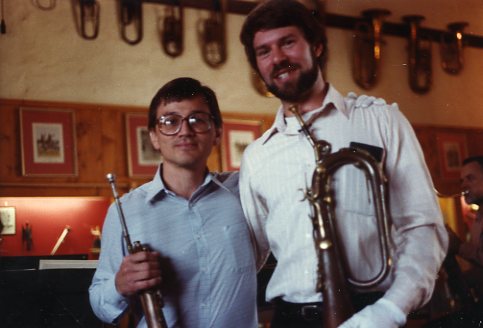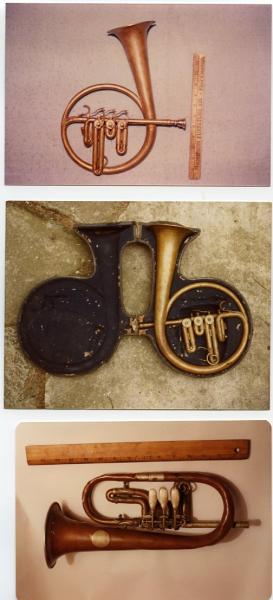Music

HAZEN'S CAREER AS A PROFESSIONAL MUSICIAN
- Founding Member, Cambridge Symphonic Brass Ensemble, 1967-1975
- Solo Trumpet, Emmanuel Bach Orchestra, Boston, 1973-1975; Guest soloist 2006-2008
- Founding Member, Washington Chamber Symphony, 1977-2003
- Founding Member, Washington Chamber Orchestra, 1980-1988; European tour, 1986
- Member, National Gallery Orchestra, 1977-2010
- Member, Washington Bach Consort, 1977-2010; German tour 2000
- Founding Member, National Chamber Orchestra, 1979-1985
- Founding Member, and Board of Directors, National Philharmonic, 2004-2016
- Alternate Musician, National Symphony Orchestra, 1978-2005; national tour, 2004
- Member, Filene Center (Wolf Trap and Wolf Trap Opera) Orchestra, 1977-2006
- Freelance Union musician, Boston and Washington, 1971-2016
Robert Hazen played symphonic trumpet professionally from 1966 until his retirement in November 2016. He was a tenured member of the National Gallery Orchestra (1977-2010), the National Philharmonic (2004-2010), and the Washington Bach Consort (1977-2010). He studied in Boston with Natalo Paella, Andre Come, and Armando Ghitalla, and in Washington with Steven Hendrickson, Adel Sanchez, Emerson Head, and Chris Gekker. He appeared as soloist with the Boston Symphony Esplanade Orchestra, the National Gallery Orchestra, the Washington Handel Festival Orchestra, the Washington Chamber Symphony, the National Gallery Orchestra, the Emmanuel Music Orchestra (Boston), and on BBC TV in England in a live performance of Henry Purcell’s Sonata in D. Hazen has given many recitals in the United States and Great Britain, including the Busch-Reisinger and Gardner Museums in Boston, the Smithsonian and Corcoran Museums in Washington, and Kings College and St. Johns College in Cambridge England. In 1998 he appeared as soloist at the Kennedy Center with the Washington Chamber Symphony, for which he played 2nd trumpet from its founding in 1977 until its demise in 2003.
 In 1967 he co-founded the Cambridge Symphonic Brass Ensemble, a brass quintet that thrives to this day. They performed hundreds of concerts and recitals throughout New England, including the first performances of the Christmas Revels at Sanders Theater in Cambridge, the first Ascension Day brass concerts from the Tower of the Busch-Reisinger Museum on the Harvard University campus, and many concerts at the Castle Hill Music Festival.
In 1967 he co-founded the Cambridge Symphonic Brass Ensemble, a brass quintet that thrives to this day. They performed hundreds of concerts and recitals throughout New England, including the first performances of the Christmas Revels at Sanders Theater in Cambridge, the first Ascension Day brass concerts from the Tower of the Busch-Reisinger Museum on the Harvard University campus, and many concerts at the Castle Hill Music Festival.
He has performed as an extra trumpeter with numerous ensembles in Europe and North America, including the Boston and National Symphonies; Orchestre de Paris; the New York, Boston, Washington, and Metropolitan Operas; and the Jeoffrey, American, Washington, Baltimore, Kirov, and Royal Ballets. His frequent appearances with National Symphony Orchestra include performances with Mistislav Rostropovich, Erich Leinsdorf, Antal Dorati, and Leonard Slatkin. He performed with the NSO on their 2004 national tour, including performances at Carnegie Hall.
He continued to perform on historic instruments until 2012 with such ensembles as the Washington Bach Consort, the Folger Consort, the Handel Choir of Baltimore, the Cathedral Choral Society, the Wolf Trap Opera, and the Washington Bach Sinfonia. Hazen has recorded on both modern and historic instruments with ensembles on DDG, Pro Arte, New World, Nonesuch, Smithsonian, and AMI records.
Robert and Margaret Hazen are authorities on the history of bands in America. They assembled one of the largest collections of brass band ephemera in the world and they wrote The Music Men: An Illustrated History of Brass Bands in America (Smithsonian Institution Press, 1987), which won the 1989 ASCAP Deems Taylor Award. They subsequently wrote the script and appeared in a documentary film on the history of bands, produced by SIRS Inc. and shown on PBS TV. The Hazen Collection of Brass Band Ephemera is now preserved in the archives of the Smithsonian Institution. More than 100 historic brass instruments collected by Robert Hazen are also in the collections of the Smithsonian Institution, the Boston Museum of Fine Arts, and the National Music Museum (Vermillion, South Dakota).
Robert and Margaret Hazen performed as semi-professional Renaissance dancers from 1972 to 1984. They were members of the Cambridge Court Dancers (Boston) and the Dupont Circle Consortium (Washington) in numerous venues, including the Boston Museum of Fine Arts, the Cloisters, Dumbarton Oaks, the Folger Theatre, and the Smithsonian Institution.
Robert Hazen is also an amateur cellist. He plays regularly with Margaret Hazen (a violist) and a growing circle of musical friends. They completed their first Beethoven string quartet cycle in 2012 and are now engaged in a Shostakovitch cycle.

HISTORIC BRASS INSTRUMENTS
The Hazen collection of historic brass instruments consists of approximately 25 natural, keyed, and valved soprano brasswinds from c.1800 to the modern era. Highlights of the collection include Eb saxhorns by J. Lathrop Allen and E. G. Wright, as well as a set of matched 19th-century British Eb natural trumpets.
Robert Hazen was a dealer in historic brass instruments in the 1980s. Many of his most important finds are now in the Smithsonian Institution collection, which acquired approximately eighty 19th-century cornets, saxhorns and other brass instruments from him. An important collection of keyed bugles was acquired from Hazen by the Shrine to Music Museum in Vermillion, South Dakota.
MUSIC FILES
Bach, Cantata #5 “Wo sol lich fleihen hin?” performed by the Cantata Singers, Sanders Theater, Harvard University, December 5, 1973. Philip Kelsey, conductor. Susan Larson, soprano; Dianna Fortunato, alto; Karl Dan Sorenson, tenor; David Evitts, bass. The seven movements are (1) chorus, (2) bass recit, (3) tenor aria with viola, (4) contralto recit with oboe, (5) bass aria with trumpet, (6) soprano recit; (7) chorale. We did Bach Cantata #77 on the same program. (21’55”) [play]
Bach, Cantata #51, final “Alleluia”: performed October 12, 2002 at my Mom’s memorial service at the Pacific Palisades Presbyterian Church, Pacific Palisades, California. Frances Young, soprano; Maria Newman, violin; Rosemary Hyler Ritter, continuo; Sara Parkins, violin; Sebastian Toettcher, cello. (2’35”) [play]
Purcell Sonata in D, movement 3: performed October 12, 2002 at my Mom’s memorial service at the Pacific Palisades Presbyterian Church, California. John Steele Ritter, organist. [play]
Bach, Cantata #76, opening chorus. Performed by Emmanuel Music. Craig Smith, conductor. (4’40”) [play]
Bach, Cantata #76, All. Performed by Emmanuel Music. Craig Smith, conductor. (38’40”) [play]
Bach, Cantata #126, opening chorus. Performed by Emmanuel Music on February 23, 2003. Criag Smith, conductor. (2’35”) [play]
Bach, Cantata #190, opening chorus “Singet dem Herren ein neuse Lied”, performed by the Washington Bach Consort on Tuesday, February 4, 2003, at the Church of the Epiphany, Washington, DC. Stan Curtis, Bob Birch and Bob Hazen, trumpets. Riley Lewis, conductor. (5’20”) [play]
Joseph Forestier’s “Fantasie Brilliante” (c.1842): Performed at the Corcoran Gallery of Art, January 25, 1992, on my Washington Chamber Symphony recital. That night we had a horrible slushy snow storm and I almost had an accident getting to the museum. Many people who bought tickets didn’t show, so they sold them at the door, filled the house, and ended up selling more tickets than seats! The great pianist was Dale Anthony, who died of AIDS a few years later. This “Fantasie” was one of the first pieces ever written for valved brass and keyboard, and was one of each such solos I discovered bound together in an old Parisian volume. They are described in my article: Hazen, R. M. (1995) Parisian cornet solos of the 1830s and 1840s: The earliest solo literature for valved brass and piano. International Trumpet Guild Journal May 1995, 34-38. Other pieces on the recital included concertos by Telemann and Haydn, the Purcell Sonata, and the Saint-Saens “Septet” Op. 14 with members of the Washington Chamber Symphony. [play]
Telemann “Concerto in D for Oboe, Trumpet, Strings and Continuo” was performed on March 2, 1990, with the Washington Chamber Symphony, Steven Simon conducting and harpsichord, at the Terrace Theater of the Kennedy Center in Washington. Robert Hazen, trumpet; Phyllis Lanier, oboe; Haesoon Haen and Mary Price, violins.(26’40”) [play]
Vejvanowsky, “Concerto for Symphony Orchestra” as performed by the Washington Chamber Symphony, September 16, 1987, at the Terrace Theater of the Kennedy Center in Washington. Trumpets include Robert Hazen, Dennis Edelbrock and Dan Smith. (12’25”) [play]
Saint-Saens "Septet", January 25, 1992. [play]

